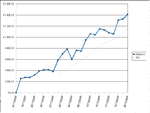Orwellian wisecracks aside, I think in my year of trading this might be the first comprehensive three month plan I have made, and out of all my trading plans this is the one I have the most chance of sticking to. I first introduced this on the
Dow thread last night, but it belongs here.
The Plan
The Markets
Major foreign exchange crosses. I am using the ones that I monitor on my pin bar alert service. Some of the more exotic pairs are excluded because of the high dealing spread, but I have most of the G8 currencies and their major crosses in my watchlist.
I will not be trading indices with this system.
The Timeframes
Hourly and upwards. I'm considering hourly, four hourly, daily, and weekly timeframes (although I am yet to trade off a weekly).
The Setup
"Pin" bar reversals as explained on Trader Dante's "Making Money Trading" thread (link in signature). I will use price action, trend, fundamentals, fib retracements, and S/R zones when deciding whether a trade is worth taking.
The Entry
Enter a long (short) setup with a stop order above (below) the high (low) of the pin bar. If for some reason I have missed the initial break, it is permissible to enter at a price
better than the textbook entry - ie if the next bar has retraced into the body of the pin. I'll pay heed to the level of the left eye when deciding to do this. However, I will not enter at a
worse price than the optimal entry on the break of the pin, as this is chasing the market. (this evening for example I missed a great trade on the GBP/CHF due to my platform locking up and not giving a price before the pin broke - I passed on the trade and missed out, but did not chase the market.
The Trade
The trade will be managed according to these rules and any supplemental in my written trading plan which is done before or at the time of entry.
The Exit
One of the most important parts. Firstly, I will make a note of important price levels which the market may stall or reverse at subsequent to my entry. Initial stop will be on the other side of the pin. Stops can only be moved closer to the market. I will trail the stop according to the extreme of each successive hourly bar. On a long position, I will trail the stop to the low of each hourly bar at the close of the hour if the bar makes a new high. Getting stopped out in this fashion will take me out of most trades. I may cover at the market on a failed test of an important price level, however I do not intend to panic an exit or exit on the first hourly bar (unless stopped out).
The Risk
No more than 10% of the account on any given trade. No more than 30% drawdown in a week (this would represent at least 3 losing trades, and would be cause to reexamine the system). Stops not moved from the other side of the pin until they can go in at breakeven or better. Total account risk must not exceed 30% (ie max 3 open trades).
The Period
Three months from yesterday (the plan was used today).
The Review
Each trade to be posted and reviewed by at the latest the end of the first weekend following the trade. Any profits, losses, panic exits, breaches of discipline, etc will be recorded. Charts and account statements to be posted. Equity curve to be updated each time I receive a monthly statement from my broker.
The Reward
Hopefully some profit on the 3 month period. More importantly however, three months of only executing one strategy live in the markets in real time. (Of course I will be reading, testing, hypothesising etc many markets and instruments, but this will not affect my live trading of this one setup)
As I mentioned in my post linked above, the real reward for doing this will be (if I am successful), the knowledge that I have been able to achieve consistency in my execution (and hopefully my results), and further to give something back to all who have helped me.
Question for all those who have given of their time throughout my journey this year:
Would you be pleased if I was able to follow this plan exclusively for three months, whether or not I made a profit? I think I know the answer to that. It is high time I demonstrated some consistency and discipline.
Seasons greetings and good trading to you all. Thanks for reading. Hopefully I'll have some good results to be posting here irrespective of pips, I'll make myself (and others I trust) very happy if I can stick to this.


